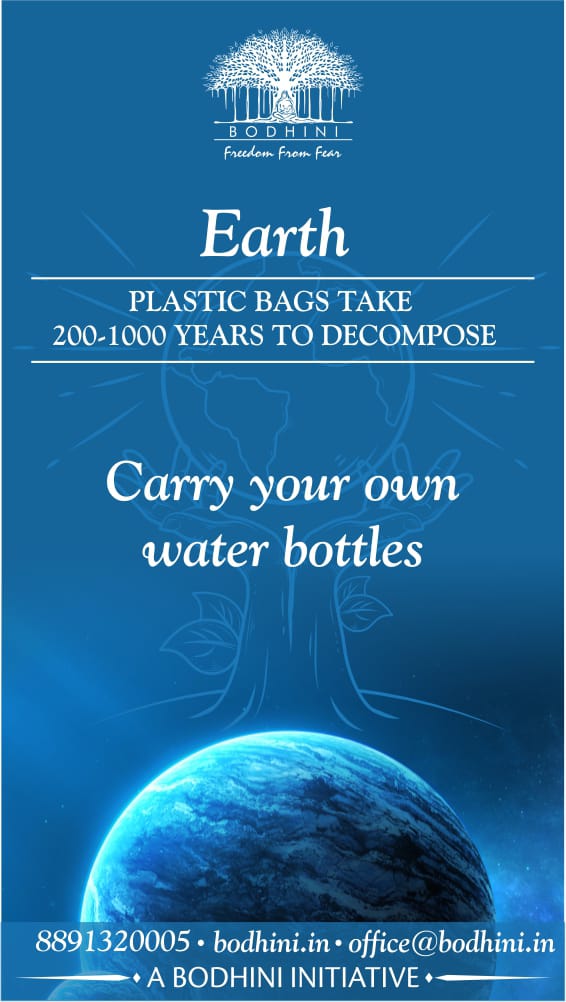You might be wondering why an NGO, working mainly in the spheres of online safety issues, sexual violence and healing, has come to develop an Earth segment. The answer is simple: we, at Bodhini, believe that connecting with nature and the Earth can help us to heal and move forward.
Healing is a crucial part of Bodhini’s work and we believe that nature’s elements are powerful resources to tap into in the journey towards healing. When we help to heal the Earth, we take another step towards healing ourselves.
Bodhini’s goal is to help individuals reach out and connect to NGOs working with nature to help make healing possible.
We are also trying to facilitate a platform where individuals can find resources to nature and earth, like gardening, micro-greens, sustainable products, recycling, proper waste disposal, medicinal plants, etc. to bring back the healing wonders of nature’s gifts.













Sustainable living is a philosophy that looks to reduce the impact of individual and societal activities on the environment and the Earth. The ultimate objective of making sustainable choices is to achieve a lifestyle that allows you to live within the Earth’s capacity to replenish. While no one can be perfectly sustainable, there are many ways to live a conscious life. The most important part of this process is to take the first step, and to do it with kindness – kindness to yourself, and to the planet.
Generating less waste – reusing, recycling, and upcycling
Lifestyle changes like carrying reusable dishes, water bottles, straws, and bags are easy ways to reduce the amount of waste you generate.
Bare Necessities, a company that produces zero-waste lifestyle products, also hosts educational workshops, and conducts sustainability consulting services. They provide self-paced online courses that are a good place to start your journey towards buying and throwing away less.
While making purchases it is advisable to try to buy products with minimal packaging or those that use materials that can be recycled or have been made from recycled waste. Paperman, an organization started to accelerate recycling in India, provides several services aimed at helping India manage its trash through a circular economy model. Plastics for Change also uses plastic waste as a resource to address social issues and encourages companies to start sourcing recycled plastic. Similarly, Namo E-waste allows you to schedule pickups for your electronic waste and transports it back to its recycling plant. You can also get involved with Thanal in Trivandrum, which runs a zero-waste center that trains communities in waste management, among other ambitious projects.
Upcycling is another alternative to discarding your belongings. It entails the creative reuse of waste to create new products with alternate uses. You can use discarded bottles as bird feeders, use waste to build furniture, create lanterns with old glass jars; the possibilities are endless. If you don’t have the time, several organisations and self-help groups across the country collect scrap material to upcycle into toys, bags, rugs, etc. You can find an organization that uses this material, and donate to them. For instance, Amrita SerVe is an organization that trains women in villages to undertake upcycling, facilitating self-reliance. Some Kudumbashree units in Kerala are also trained to upcycle discarded materials.
Composting
Recycling organic waste such as food scraps and leaves is an incredible way to give back to the soil what is taken from it. The Local Self Government Department of Kerala’s Suchitwa Mission recognizes several service providers across the state who assist in creating individual and community compost facilities to further this practice.
Creating a vegetable garden
Combining composting with a vegetable garden can reduce your carbon footprint significantly. Not only does it address the emissions involved in transportation of produce, you can also be environmentally friendly by avoiding chemical fertilizers and pesticides. The Vegetable and Fruit Promotion Council Keralam provides seeds, potted plants, and training to those who wish to get involved in organic and terrace farming.
Conscious eating
Changing your eating habits can be another way to play your part in reducing the carbon in the atmosphere. Meat accounts for almost 60% of the greenhouse gases from food production, with beef producing the largest quantity, followed by lamb. By reducing the amount of red meat that you consume, you can lower your personal greenhouse gas emissions. Using locally sourced and seasonal fruits and vegetables can also contribute to a sustainable lifestyle. Taking stock of the amount of water, pesticides, and fertilizers used to grow certain foods and using that information to inform your food habits is important.
Slow fashion
While it is tempting to keep up with ever-changing fashion trends, it is important to recognize that the fashion industry is responsible for approximately 10% of global carbon emissions annually. Furthermore, 92 million tonnes of textile waste is produced every year. As an alternative to buying and discarding clothes seasonally, one must try to buy good quality, environmentally friendly products and take sufficient care to maximize their lifespan. Once they have outlived their use, recycling or upcycling, as described above are good alternatives to disposal.
Conscious travel
At 90kg of carbon dioxide per passenger per hour, airplane travel has a significant footprint. Commercial flights account for approximately 2.4% of global greenhouse gas emissions. Additionally, a typical passenger vehicle emits about 4.6 metric tonnes of carbon dioxide per year. While it is important to reduce one’s air travel, you can also reduce your emissions while travelling locally by using public buses, trains, and other forms of transport over personal cars. Carpooling is also an alternative to traveling alone in a vehicle.
Offsetting your carbon footprint
It is impossible in today’s world not to have a carbon footprint. Companies like Climes allow you to calculate your consumption and compensate by offsetting your footprint. For instance, Climes, in collaboration with travel booking companies, calculates the emissions of your journey and offsets it by allowing you to pay to support projects that rejuvenate the planet by increasing forest cover or soil carbon.
Reducing your digital carbon footprint
If the 1.7 billion tonnes of greenhouse gas emissions produced in the manufacture and running of digital technologies were to be divided amongst all the internet users around the world, each of us would be responsible for the production of 414 kg of carbon dioxide a year. Global emissions from cloud computing alone ranges from 2.5 – 3.7% of all greenhouse gases emitted globally, exceeding emissions from commercial flights. You can reduce your contribution to this by being mindful of the amount of cloud storage you use and by deleting unnecessary content. Other ways to reduce your emissions is to reduce internet streaming by downloading content, and viewing videos at lower resolutions while streaming for long durations. Unsubscribing from spam or automatically generated promotional emails can also play a role in reducing emissions as a typical email is responsible for 4 grams of carbon dioxide.
Being accountable for our actions
It is just 100 companies that are responsible for 71% of global emissions. Apart from individual action, it is necessary to understand the impact of our consumption and ask for better from these companies. Participate as citizens in the law-making process and hold your representatives accountable so that our environmental laws take necessary steps to reduce pollution and emissions. To this end you can engage with the Centre for Environment and Development, ATREE CERC, WWF, and other such organisations that work in the fields of environment and sustainability. Let your voice be heard.
In order to make children environment conscious, they need to be made aware of the different ecological aspects of the world that they are inhabiting. While we insist on teaching our kids about many things, the environment usually takes a back seat. To have a whole and fulfilling life, children should be aware of the world around them. Therefore, it is important that we tell them about it and raise them to be eco-conscious. You may try some of the following some pointers:
Create awareness: The world around us is changing. The earth is changing. The reason we neglect that truth is because we do not hear about it enough. This fact is not represented enough in the news, books, tv shows or movies. Though there is a lot of news about the increasing instances of natural calamities like floods, heat waves, etc., there is not enough coverage about climate change, which is one of the causes of these calamities. Though they talk about wild animals entering cities, there is not enough reporting about habitat destruction. Therefore, it is upon us to take the initiative and learn about the reasons behind these. We must ourselves learn about it before we can pass it onto our children. Children are naturally curious so it might be easy for you to get them interested about the things happening around them.
Be conscious: Children are imitators. They imitate everyone around them. They, especially, imitate their parents. It would help if you can actively do some ecofriendly activities in their presence. You can take covers or cloth bags from home when you go shopping so that you need not buy a plastic bag. You can also say no to free plastic bags and use the ones you brought instead. Teach them to segregate their waste and put them in separate bins. Try to compost if you can. Show the kids how it is done. Children grow out of clothes. They need new books every year. You can donate their old clothes to collection centers or to people who may need them. Books can be given to stores that sell second hand books. You can buy thrifted or preloved clothes and other things for yourself or your children. You can make your child a part of this so that they would have a gateway into knowing how to not let things go to waste. Take water bottles with you while travelling. This way, you do not have to buy plastic water bottles. These small things can create long-lasting habits for children. Conserve water and food. Teach them to close water taps after use. Train them to take food only as much as they need so as to avoid wastage.
Be hopeful: You cannot inspire anyone to conscious living by saying ‘the world is going to end.’ That would mean that whatever we do is pointless. We would be inspired to do better when we know that the changes we make are going to have an impact. We can tell children that positive steps have positive effects. Coral reefs are recovering. Locally extinct animals are being re-introduced and are seen breeding. We can actively read upon these stories and tell them to kids as per their level of understanding.
Spend time with your child outdoors: Children have a natural liking to spend time outdoors. Take them for a walk to your garden, a local park or any such place. Draw their attention to the trees, butterflies, birds, etc. around them. Tell them whatever you know about these things. Encourage them to listen to the sound of insects and birds. This will create an appreciation for these things in their mind. Introduce them to gardening. If they develop an interest in them, they can pick it up as a hobby. You can gift them a small plant and ask them to water it.
Involve in community projects: Finding a community that shares eco-concerns is a great way to sustain a common interest. Such communities check with each other and keep each other informed. School clubs or inter-school clubs are a great way to do that. If there is such an initiative in your building society or residential association, the kid can join that. If there is not one in your area, you can take the initiative and start one. Remember to only slightly nudge your child in the direction. Compelling them to join these clubs and involve in these activities against their wishes can cause them to dislike it all together.
Books and stories: Nowadays, there are many books in the market that talk to kids about tress, animals, plastics, waste, recycling, food etc. There are many Indian authors who have written about these. These stories are closer to home and more relatable. Such stories can give kids a better understanding of these concepts.
Useful links
Positive environment stories from 2022 so far: https://www.euronews.com/green/2022/08/31/here-are-all-the-positive-environmental-stories-from-2022-so-far
9 Indian books that teach children the need to protect environment: https://scroll.in/article/876413/earth-day-nine-indian-books-that-teach-children-and-adults-the-need-to-protect-the-environment
7 Books to teach children about environment: https://www.thebetterindia.com/174051/children-books-environment-nature-awareness-india/
21 books that teach children about the environment: https://www.thecuriousreader.in/bookrack/children-environment-books/
Urban living and our increased dependence on technology have resulted in extended periods of time indoors. This was further exasperated by the COVID-19 pandemic. Studies show that this lifestyle has been connected to lowered physical activity levels, less time outdoors, attention deficiency, and higher sedentary behaviour.
In contrast, spending time outside in green spaces can improve psychological and physical wellbeing. Research has shown that there are cognitive benefits to interacting with nature, including improvements in mood, self-confidence, self-control behaviours, attentional functioning, and working memory.
There are several hypotheses regarding why this is the case. One such theory (biophilia) suggests that our innate need to connect with nature is rooted in evolution, while others suggest that the stress reduction and attention restoration properties of nature are at play. No matter what the reasons, time spent simply looking at nature or listening to the sounds of nature can improve productivity, concentration, and stress levels, and contribute to lower blood pressure, heart rate, and muscle tension.
A study in Denmark found that children who grew up in residential areas with more access to green spaces were at lower risk of developing psychiatric disorders from adolescence into adulthood. Another study found that students were more generous to their classmates after a visit to a nature school, positing that the sense of awe experienced after time in nature makes children feel like part of something bigger.
Harnessing the power of nature
Studies show that a minimum of two hours a week spent in nature, at once, or at different instances, can significantly improve health and wellbeing. There are many ways one can interact with nature; some of the ways children and adults can be engaged in activities outdoors include:
1. Forest bathing
Forest bathing, a practice that first emerged in Japan (Shinrin-yoku), is not specific about the outdoor experience. While it could be a guided experience, it could also just be time standing in nature and engaging with sights, sounds, and smells.
2. Plogging
Originating in Sweden, plogging is a combination of jogging and picking up litter. Not only does it allow one to spend time outside, but also lets you contribute to your community directly.
3. Kayaking:
Kayaking is a fun way to get some exercise and be outdoors; you get both an endorphin rush and time in nature. One of the best things about being in Kerala is that a body of water is not far away. Kayaking is becoming quite popular, and one can find a service that facilitates kayaking, as well as a community of people with shared interests.
4. Gardening
Planting a seed, providing care, and watching it grow into a plant improves your mood and self-esteem. Not only do houseplants improve mental health and cognitive performance, but they also provide additional benefits such as improved air quality. Community gardens can also encourage individuals to interact with others and build bonds. Furthermore, spending time gardening has other benefits: mycobacterium vaccae, found in soil, has been proven to promote serotonin production.
5. Birdwatching
Birdwatching is a great outdoor activity for adults and kids alike. It allows you to get outside and get some fresh air while at the same time encourages you to learn about your local biodiversity, conservation efforts, and ways in which you can interact with your surroundings.
6. Cycling
By cycling, you not only reduce your carbon footprint, but you also reduce endorphins, i.e., feel good hormones, relaxing your mind making you happier. Studies have shown that those who cycle regularly are at a significantly lower risk of feeling stressed.
7. Yoga and meditation
Yoga and meditation have been incorporated into mental health treatment due to their ability to reduce stress, anxiety, and depression. Engaging in these activities in the outdoors is a sure shot way to improve one’s mental health.
There are several other outdoor activities that have the same effects. Urban living is a relatively new concept, and we have long been connected to our environment for our survival. As time indoors increases alongside screentime, it is essential to take the time to be one with nature in order to live a well-rounded life; mediated by physical activity, there are only benefits for physical and mental health when you take time away from the concrete that we surround ourselves with.